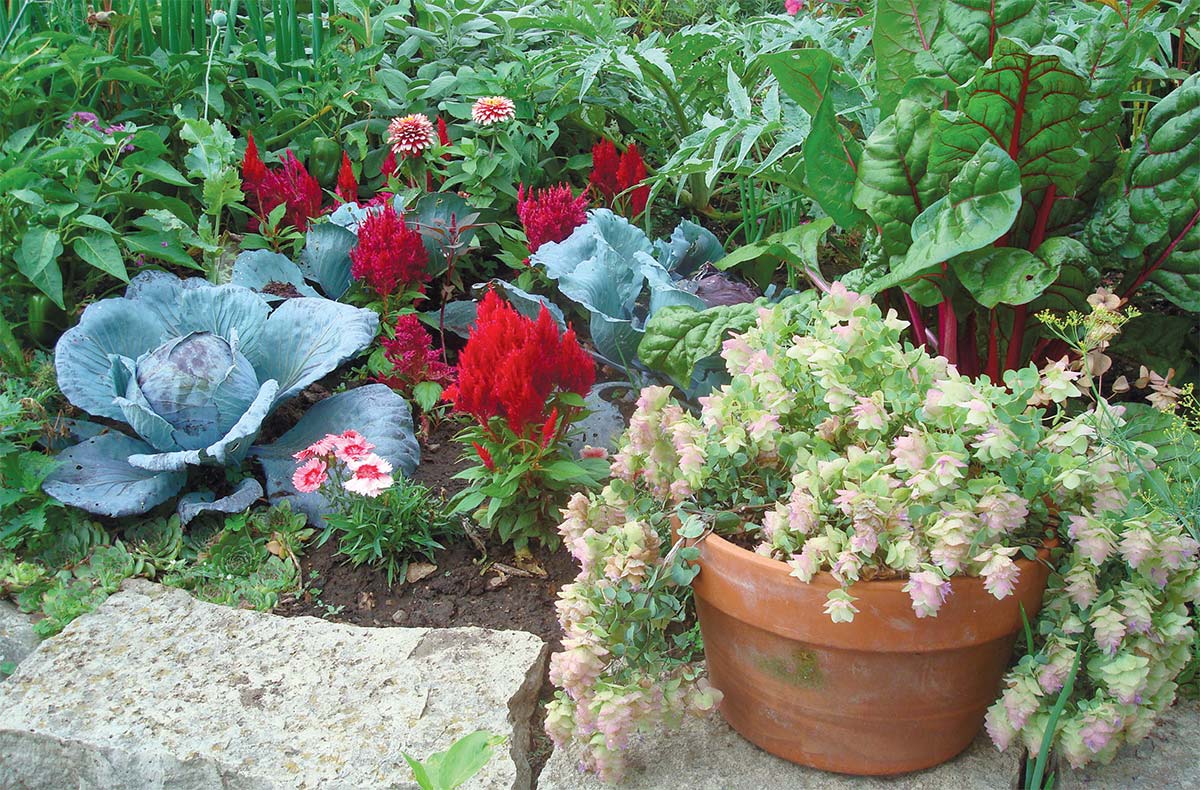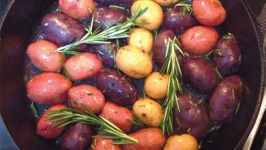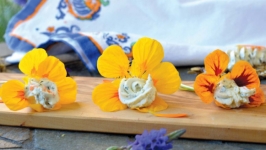The Tasteful Art of Foodscaping
MIXTURE OF BLOOMING AND EDIBLE PLANTS CAN BE A 'WONDER'
The famed Hanging Gardens of Babylon may have been the first example of “foodscaping,” combining grape arbors, shrubs of cinnamon and saffron and other scented herbs, along with blossoms that King Nebuchadnezzar hoped would keep one of his many wives from getting homesick.
While today’s gardener may not be able recreate one of the Seven Wonders of the Ancient World, they can, by planting edibles among blooming plants, provide fruits, vegetables and herbs to please the palate along with flowers to grace the home.
Growing up in Kaukauna, Master Gardener Carrie Sherrill loved gardening with her dad as a little girl.
“Our favorite time of the year was looking through the Jung Seed catalog and he would let me choose one flower,” she recalls. “We really couldn’t afford it but it was a big treat, so he’d pick all the vegetables and I would pick one flower every year.”
Her dad had to overcome a disability that affected all he did, and young Carrie’s love of gardening became even more important to her when she lost her dad at the age of 15. When she retired from a nursing career in 2015, she said she was going to take a year to decide what she wanted to do. That “year” lasted about four months when she saw a notice for a Door County Master Gardeners’ Association class. Since then, she has put in more than 1,000 volunteer hours with the Association and has held several leadership roles.
She started “foodscaping” after ripping out landscaper-installed perennial beds at her rural Door County yard in Kolberg because she didn’t like what they had planted. She ended up starting all over and soon realized the gardens were not getting enough sun because they were too close to the house.
“In the areas where I do have sun, I started intermingling tomato plants and things that need more sun,” she explained. “It’s not unusual to come to my house and see basil mixed in with perennial shrubs, lilacs and all kinds of stuff. I just mixed it all together, but as I did more research on the flowers I realized there’s a benefit to planting some of the flowers near the plants. “I started planting marigolds around my garden because they deter the rabbits; they’re pretty and you can eat them.”
Mark Konlock, director of horticulture at the Green Bay Botanical Garden, said they strive to make foodscaping easily accessible to home gardeners by combining vegetable plants with flowering annuals in small plots or in containers which easily adapt to limited space.
“There’s been a lot of work done on tomatoes, peppers and others that can be grown on your patio or in a container,” he explained. Imagine putting a miniature eggplant as dark as a dragon’s heart into a patch of sun-bright yellow coneflowers or spiky chives in a nook between plants of orange, red and golden nasturtiums.
Konlock said one of his favorites is Bright Light Swiss Chard that has almost-glowing stems of yellow, magenta, green and orange. These streaks of color can be used to echo the colors of the flowers incorporated into the planting.
For Diane Blazek, the executive director of All-America Selections, a nonprofit testing organization of plant varieties, blending edibles into landscaping is one of the most exciting trends in gardening. Blazek advises gardeners “to grow the unique things because there’s a bit of pride and ego involved when you’re serving your friends and you can tell them it came from your garden. They’ll be wowed by how great it tastes.”
In Blazek’s opinion, some of the most foodscaping- friendly plants include patio baby eggplant that boasts glossy small fruits and brilliant white blossoms; an edible pepper called “Pretty and Sweet” that has ornamental qualities; and the “Delizz” strawberry that is easily grown from seed and also has white flowers.
“And don’t forget fennel,” said Blazek. “Fennel fronds make a great focal point for a container. Then, of course, you have the whole aspect of it being pollinator-friendly for the swallowtail butterfly. You can eat the fennel pollen and then the bulb! It’s pretty next to the petunia, but then I get to eat it at the end of the season when it’s ready.”
Lynn Clark from the Green Bay Master Gardeners chapter suggests orange and white mini pumpkins.
“Scarlet runner beans are another one I really like because they’re colorful and will draw butterflies and hummingbirds,” she said. “When they mature and are dried, they are a brilliant fuchsia with purple splotches.”
Assistant Horticulture Director Lindsay Hendricks is in charge of the Cottage Garden at the Green Bay Botanical Garden.
“Back in the day of the kings and queens, all the servants had their little cottage area but they didn’t have a lot of money or space, so they had to grow everything within their little confines,” Hendricks said. “They had to mix their vegetables in with all their pretty flowers.”
Hendricks said she tucks the tomatoes, peppers and herbs into any little gaps she has. She uses kales, fennels and different colored sages. In combination, these plants provide a welcome spot for butterflies, bees and other pollinators as well as cover and food for birds.
GBBG horticulturalist Sara Pingel likes to intersperse marigolds with basil in between.
“They always say marigolds and tomatoes work well together, but then you can easily mix others in as well,” she said. Pingel likes mixing carrots and other root vegetables in with edible flowers like pansies, making it all edible with the edible blossoms as a bonus.
DIVERSITY HELPS CONTROL PESTS
“Eventually you can get a little ecosystem of everything that will keep itself in balance; then you have less work to do and you can just enjoy your garden,” Konlock said.
Clark is quick to agree. “A healthy garden doesn’t mean a bug-free garden; you’re going to have bugs and you should.” Bugs also provide prey for other insects and birds, a combination that promotes a natural, healthy environment.
If a front yard display is the goal, perennial herbs mixed with native plants may prompt compliments from the neighbors, according to Konlock.
“They’re going to attract insects that are on the base of the food chain, pollinators or beneficial insects,” he explained. “Coneflowers, or a little blue stem in there for texture. We use the Montrose white calamint, which is a super pollinator magnet.”
Perennial herbs that grow well in a cold climate include lavender, sage, bee balm, lemon balm, chives, bronze fennel thyme and mint. Some herbs tend to spread or reseed. They can be controlled from taking over large parts of the lawn by clipping off the blossoms before they seed. Those who work with edibles in the landscape are excited about it.
“For me, I really do not like formal plantings where everything has to be in straight rows,” Hendricks said. “I like being able to not follow any rules or directions; when you incorporate edibles you can have them work together. You can personalize it.”
Clark believes it makes for a healthier garden.
“You are incorporating so many different types of plants that you’re inviting in different insects, so you have a great variety of wildlife in there.
Advice for the first-time foodscaper? Start small.
“Just start with a couple things that you know you like to eat,” Konlock advises. “Start in a container, maybe, or just use basil to edge your garden.”
Don’t fear trial and error. If something doesn’t grow well, try something else next year until you find the plants that do well in the particular spot you live.
Sherrill is thrilled by the growing number of young people interested in foodscaping. She loves it when her grandchildren come to the house and pick tomatoes to eat fresh off the plant and believes it is another way parents and their children can learn where their food comes from.
“Kids are learning that carrots grow under the ground, not above it,” she said. More information about foodscaping can be found at gbbg.org, allamericaselections.org, newmastergardeners.org, johnnyseeds.com and dcmga.org






